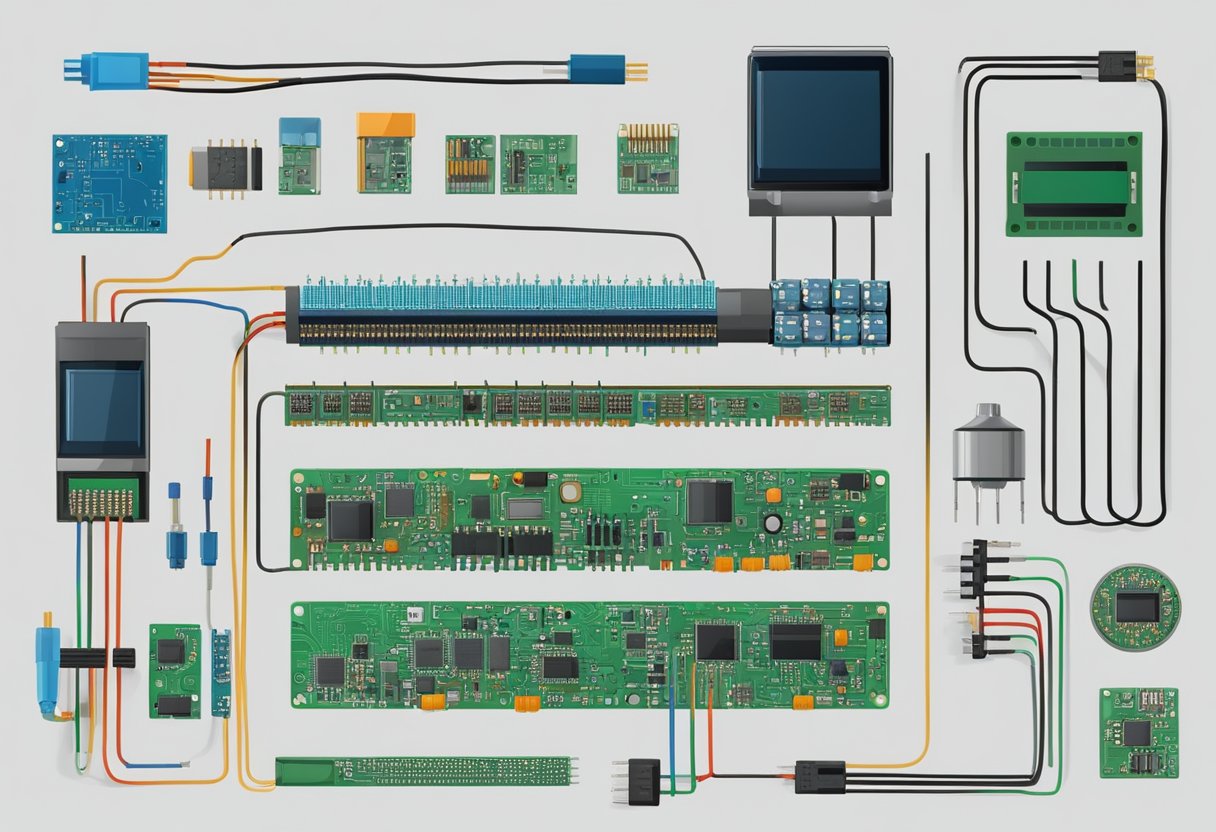Types Of Electronic Connections
Electronic connections are an essential part of modern-day technology. They allow for the transfer of data and power between devices, enabling them to communicate and function together. There are various types of electronic connections, each with its own design, form factor, and use. Understanding these different types of connections is crucial for anyone working with electronics, whether it be for personal or professional use.
Fundamentals of electronic connections involve understanding the basics of electricity, such as voltage, current, and resistance. Connector design and form factors must also be considered, as different connectors are designed for different purposes and applications. Wiring and connection types are also important, as they can affect the performance and reliability of the connection.
Interconnection techniques are used to connect two or more electronic devices together. These techniques can include soldering, crimping, or using a connector. Electronic connector types and uses vary depending on the application, with some connectors designed for high-speed data transfer, while others are designed for power transmission. By understanding the different types of electronic connections, one can make informed decisions on which connections to use for a particular application.
Key Takeaways
- Understanding the fundamentals of electronic connections is important for working with electronics.
- Connector design and form factors, wiring and connection types, and interconnection techniques must be considered when choosing a connection.
- Electronic connector types and uses vary depending on the application.
Fundamentals of Electronic Connections

Conductivity and Materials
When it comes to electronic connections, conductivity is crucial. Conductivity refers to the ability of a material to conduct electricity. In electronic components, metals are the most commonly used conductors. Copper is one of the most popular materials for electrical connections due to its high conductivity and low cost. Other common conductors include tin, gold, phosphor bronze, and beryllium copper.
The choice of material for electronic connections depends on the specific requirements of the application. For example, gold is often used for connectors that require a high level of reliability and durability, while tin is used for soldering connections due to its low melting point.
Types of Electrical Connectors
There are various types of electrical connectors used in electronic connections. Some common types include:
- Wire-to-wire connectors: Used to connect two wires together.
- Wire-to-board connectors: Used to connect wires to a circuit board.
- Board-to-board connectors: Used to connect two circuit boards together.
- Terminal blocks: Used to connect multiple wires to a single connection point.
Each type of connector has its own advantages and disadvantages. For example, wire-to-wire connectors are easy to use and allow for quick connections, but they may not be as reliable as other types of connectors. Terminal blocks, on the other hand, are more reliable but can be more difficult to use.
Overall, choosing the right type of connector depends on the specific requirements of the application and the level of reliability needed.
Connector Design and Form Factors
Electronic connectors come in various designs and form factors, each with its unique features and advantages. This section examines the various aspects of connector design and form factors, including connector housing and insulation, gender, and contact design.
Connector Housing and Insulation
Connector housing and insulation are critical components of electronic connectors. The connector housing is the outer shell that holds the connector’s internal components, while the insulation provides electrical insulation between the connector’s contacts. Connectors can have plastic or metal housings, depending on their application. Plastic housings are lightweight, cost-effective, and easy to mold into different shapes and sizes. In contrast, metal housings are more durable, offer better shielding against electromagnetic interference, and are suitable for high-temperature applications.
Gender and Contact Design
Connectors can be male or female, depending on their design. Male connectors have pins that fit into the female connector’s sockets, while female connectors have sockets that receive the male connector’s pins. The contact design is another critical aspect of connector design. Contacts can be made of different materials, including copper, gold, and silver, depending on the application. Gold contacts are ideal for high-frequency applications because they offer low contact resistance and excellent corrosion resistance. Silver contacts are suitable for high-current applications because they offer low contact resistance and high thermal conductivity.
In conclusion, connector design and form factors play a crucial role in electronic connections. The connector’s size, form factor, housing, insulation, gender, and contact design are all essential considerations when selecting a connector for a particular application. By understanding these factors, engineers can choose the right connector for their application and ensure reliable and robust electronic connections.
Wiring and Connection Types
When it comes to electronic connections, there are various types of wiring and cables that are used for different purposes. These wiring and connection types can be broadly classified into two categories: cable types and structures, and signal transmission and data transfer.
Cable Types and Structures
Cables are an essential component of electronic connections, and they come in different types and structures. Some of the common cable types include coaxial cable, fiber optic cable, and power cords.
Coaxial cable is used for transmitting high-frequency signals, such as those used in cable television and internet connections. It consists of a central conductor, an insulating layer, a metallic shield, and an outer jacket.
Fiber optic cable, on the other hand, is used for transmitting data over long distances at high speeds. It consists of a core made of glass or plastic fibers, an insulating layer, and an outer jacket.
Power cords are used for supplying electrical power to electronic devices. They consist of two or three wires, with each wire having a specific function. For instance, the black wire is used for supplying power, the white wire for neutralizing, and the green or bare wire for grounding.
Signal Transmission and Data Transfer
Electronic devices use different methods for transmitting signals and transferring data. Some of the common methods include USB and Ethernet connections.
USB (Universal Serial Bus) is a popular connection method used for connecting devices such as computers, printers, and mobile devices. It allows for high-speed data transfer and can also supply power to the connected device.
Ethernet, on the other hand, is a wired networking connection that is commonly found in computer networks and internet connectivity. It allows for the transfer of data between devices at high speeds and can also provide power over the connected cable.
In conclusion, understanding the different types of wiring and connection types is crucial for ensuring proper electronic connections. By choosing the right cable type and connection method, you can ensure that your electronic devices function properly and efficiently.
Interconnection Techniques
When it comes to electronic connections, interconnection techniques play a vital role in ensuring proper function, performance, and reliability. Two common methods for interconnecting electronic components are soldering and crimping.
Soldering and Crimping
Soldering is a technique that involves melting a metal alloy, known as solder, to join two metal surfaces together. This method is commonly used for connecting wires to terminals, as well as for mounting electronic components to printed circuit boards (PCBs). Soldering provides a strong and reliable connection, but it requires skill and practice to perform correctly.
Crimping, on the other hand, involves using a specialized tool to compress a metal connector onto a wire. This creates a secure and reliable connection without the need for heat or solder. Crimp connectors come in a variety of shapes and sizes, making them suitable for a wide range of applications.
Mounting and Termination Methods
In addition to soldering and crimping, there are several other methods for mounting and terminating electronic components. Terminal blocks, for example, provide a convenient way to connect multiple wires to a single point. These blocks typically feature screw terminals, which can be tightened down onto the wires to create a secure connection.
Edge connectors are another type of interconnection method commonly used in electronics. These connectors feature a row of metal contacts along one edge, which can be inserted into a matching socket or slot. Edge connectors are often used for connecting circuit boards to other components, such as displays or input/output devices.
Overall, there are many different interconnection techniques available for electronic components. The choice of method will depend on the specific application and the desired level of reliability and performance. By understanding the various techniques and their advantages and disadvantages, electronic designers can make informed decisions when selecting interconnection methods for their projects.
Electronic Connector Types and Uses
Electronic connectors are essential components of any electronic device, enabling the transfer of power, signals, and data between various electronic devices. Electronic connectors come in different shapes, sizes, and types and are used for different purposes. In this section, we will discuss the different types of electronic connectors, their uses, and where they are commonly found.
Audiovisual and Computing Connectors
Audiovisual and computing connectors are used to connect various audio and video devices to computers and other electronic devices. Some of the most common audiovisual and computing connectors include:
- USB Connectors: USB connectors are used to connect various devices such as printers, cameras, and external hard drives to computers.
- HDMI: HDMI connectors are used to transmit high-definition audio and video signals between devices such as computers, televisions, and gaming consoles.
- D-Sub Connectors: D-Sub connectors are used for a variety of applications, including connecting computers to printers and other peripherals.
- RJ Connectors: RJ connectors are used for networking and telecommunications applications.
- IEC Connectors: IEC connectors are used for power applications and are commonly found on power cords and power supplies.
- VGA: VGA connectors are used to connect computers to monitors and other display devices.
- DVI: DVI connectors are used to transmit digital video signals between devices such as computers and monitors.
- FireWire: FireWire connectors are used for high-speed data transfer and are commonly found on digital cameras and other multimedia devices.
- Thunderbolt: Thunderbolt connectors are used for high-speed data transfer and are commonly found on Apple computers.
Specialized and High-Performance Connectors
Specialized and high-performance connectors are used in applications that require specialized features such as high-speed data transfer, ruggedness, and reliability. Some of the most common specialized and high-performance connectors include:
- Mil-DTL-38999: Mil-DTL-38999 connectors are used in military and aerospace applications and are designed to withstand extreme temperatures, shock, and vibration.
- XLR: XLR connectors are used in professional audio applications and are designed to provide a secure connection and prevent interference.
- RCA Connector: RCA connectors are used for audio and video applications and are commonly found on home theater systems and other multimedia devices.
- Test Equipment Connectors: Test equipment connectors are used in electronic testing applications and are designed to provide accurate and reliable connections.
Overall, electronic connectors are essential components of any electronic device, enabling the transfer of power, signals, and data between various electronic devices. By understanding the different types of electronic connectors and their uses, you can choose the right connector for your application and ensure reliable and efficient performance.






